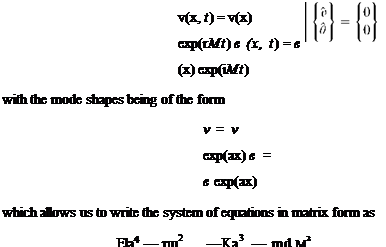Calculation of Forced Response
The formulation of initial-value problems for beams in bending is almost identical to that for beams in torsion and for strings; see Sections 3.1.7 and 3.2.4, respectively. We should first determine the virtual work done by the applied loads, such as a distributed transverse force per unit length. From this, we may find the generalized forces associated with bending. Once they are known, one may solve the generalized equations of motion, which are in the form of Eq. (3.90). The resulting initial – value problem then can be solved by invoking orthogonality to obtain values of the arbitrary constants in the general and particular solutions, as illustrated in the examples in Section 3.1.7.
3.4 Free Vibration of Beams in Coupled Bending and Torsion
In this section, the analytical treatment of coupled bending-torsion vibration of composite beams is briefly considered. The treatment is restricted to uniform beams and to the presentation of governing equations, sample boundary conditions, and suggestions for solution.
3.4.1 Equations of Motion
 |
|
First, we specialize Eqs. (2.65) for spanwise uniformity and free vibration, yielding
 |
|
Because these are linear equations with constant coefficients, for free vibration we may assume simple harmonic motion. In the spirit of separation of variables, the solutions for v and в are written as
For there to be a nontrivial solution, the determinant of the coefficient matrix must vanish, yielding
(EI GJ — K2)a6 + pIp EIm2aA — mGJm2a2 — (mpIp — m2d2)m4 = 0 (3.291)
This cubic equation in a2 may be solved for arbitrary m2. When d and K are nonzero, finding the exact, closed-form solution “by hand” is problematic. However, with the aid of symbolic computational tools such as Mathematica™, we may easily extract the six roots denoted here by ai for i = 1, 2,…, 6, as functions of m2. Note that ai+3 = – ai for i = 1, 2, and 3.
Therefore, when K, d = 0, the solution for the mode shape may be written as
v = Ci exp(aix) + C2 exp(a2x) + C3 exp(a3x)
![]() + C4 exp(—aix) + C5 exp(—a2x) + C6 exp(—a3x) в = D exp(a! x) + D2 exp(a2x) + D3 exp(a3x)
+ C4 exp(—aix) + C5 exp(—a2x) + C6 exp(—a3x) в = D exp(a! x) + D2 exp(a2x) + D3 exp(a3x)
+ D4 exp(—a1 x) + D5 exp(—a2x) + D6 exp(—a3x)
where
Now, with six boundary conditions (i. e., three at each end), we may find six homogeneous algebraic equations for Ci. The condition for a nontrivial solution leads to the characteristic equation for m2
. There is a denumerably infinite set of roots for m2, so that for any value determined for m2, we may find any five of the Ci coefficients in terms of the sixth and thus determine the mode shapes. In general, each mode shape involves both v and в. For small couplings (i. e., such that K2 < GJ EI and md2 < pIp), one “branch” of these roots is near the uncoupled bending frequencies and the other is near the uncoupled torsional frequencies.











